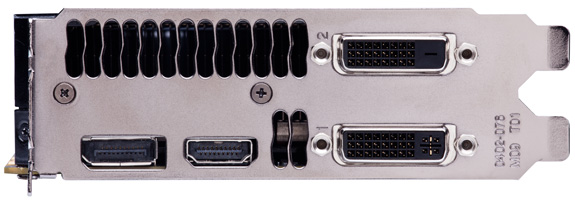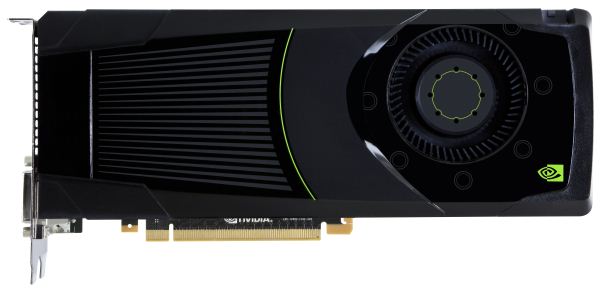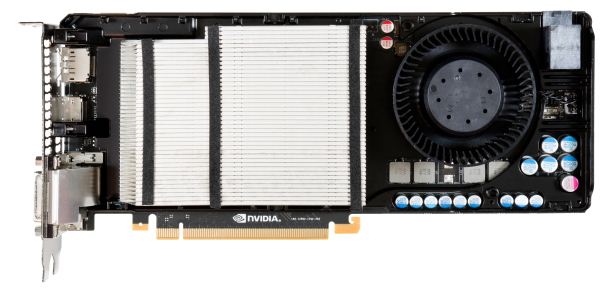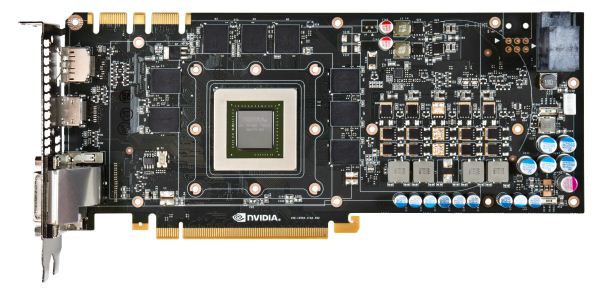NVIDIA GeForce GTX 680 Review: Retaking The Performance Crown
by Ryan Smith on March 22, 2012 9:00 AM ESTMeet the GeForce GTX 680
All things considered the design of the GeForce GTX 680 is not a radical departure from the GTX 580, but at the same time it also has some distinct differences owing to the fact that its TDP is some 50W lower than GTX 580.
Like the past GTX x80 cards, the basic design of the GTX 680 is that of a blower. A radial fan at the rear of the card sucks in air and pushes it towards the front of the card. Notably, due to a combination of card length and the fan position, the “wedge” around the fan has been done away with. NVIDIA tells us that this shouldn’t significantly impact the cooling of the card, particularly since it has a lower TDP in the first place, but when used in SLI it will remove some of the breathing room than the GTX 580 enjoyed.
Looking at the fan itself, compared to the GTX 580 the fan has been moved from the center of the card to the top of the card. This is due to NVIDIA’s port configuration, which uses a stacked DVI connector that consumes what would have normally been part of the exhaust vent on the GTX 580. We’ll get into the port configuration more in a minute, but for the moment the significance is that because the GTX 680 only has half a vent NVIDIA has moved the fan to match the vent, which is why the fan has been moved up.
On that note, the repositioning of the fan also had its own ramifications. Because the fan is now so close to the top and at the same time so close to the rear, NVIDIA went with a unique method of arranging the PCIe power sockets. Rather than having them side-by-side as we’ve seen on countless NVIDIA cards in the past, the sockets are stacked on each other in a staggered configuration. With the fan otherwise occupying the space that one of the sockets would take up, this configuration allowed NVIDIA to have two sockets without lengthening the card just to fit another socket. Overall this staggered design is not too difficult to work with, though with one socket facing the opposite way it might require some cable repositioning if you have a well maintained cable run.
Moving on, when we remove the shroud on the GTX 680 we see the fan, baseplate, and heatsink in full detail. NVIDIA is using an aluminum fin stacked heatsink, very similar to what we saw on the GTX 580. Underneath the heatsink NVIDIA is using a set of three heatpipes to transfer heat between the GPU and the heatsink. This is as opposed to the vapor chamber on the GTX 580, and while this setup doesn’t allow empirical testing, given the high efficiency of vapor chambers it’s likely that this isn’t quite as efficient, though to what degree we couldn’t say.
Finally, after removing the fan, baseplate, and heatsink, we can see the PCB in full detail. Unlike GF110 and GF114, GK104 is not capped with an IHS, allowing for the heatsink to directly come in contact with the GPU die. Meanwhile arranged around the GPU we can see the 8 2Gb GDDR5 RAM modules that give the GTX 680 its 2GB of RAM. These are Hynix R0C modules, which means they’re rated for 6GHz, the stock memory speed for the GTX 680. Overall the card measures 10” long with no overhang from the shroud, making it 0.5” shorter than the GTX 580.
Looking at the top of the card, as always we see the SLI connectors. Following in the footsteps of the GTX 580, the GTX 680 features 2 SLI connectors, allowing for up to 3-way SLI.
Meanwhile at the front of the card we see the I/O bracket. As we alluded to previously, the GTX 680 uses a stacked DVI design here; NVIDIA has done everything they can to keep the DVI ports at the very bottom of the card to avoid impeding airflow, but the upper DVI port still occupies roughly 40% of what would otherwise be the vent. Altogether the GTX 680 features 2 DL-DVI ports, a full size HDMI port, and a full size DisplayPort.

While NVIDIA has used DVI and HDMI ports for quite some time, this is the first time NVIDIA has included DIsplayPort on a reference design. Unfortunately we find that this ruffles our feathers a bit, although this isn’t strictly NVIDIA’s fault. As we’ve covered in the past, DisplayPort comes in both a full size and miniDP configuration – AMD in particular has used miniDP since the Radeon HD 6800 series in 2010. And while we’re happy to see DisplayPort finally make it into an NVIDIA reference design, the fact that it’s a full size DisplayPort is less than encouraging because at this point in time DisplayPort has largely been replaced by miniDP.
Ultimately the fault for this lies more with the VESA than NVIDIA, but it’s indicative of a larger problem in the DisplayPort community in that both full size DP and miniDP are equally valid and equally capable ports. While full size DisplayPort has the distinction of coming first, thanks in large part to Apple it has largely been displaced by miniDP as the most common variant on source devices. The problem with this is that both miniDP and DisplayPort are now in wide use; wide, redundant use.
At this point desktop computers and video cards coming with full size DisplayPorts is silly at best, and frustrating at worst. The laptop guys aren’t going to give up miniDP due to the space savings, and there’s no significantly good reason to use DisplayPort on desktops when miniDP offers the same functionality. We would rather see the PC industry standardize on miniDP across all source devices, and thereby eliminate any ambiguity with regards to what cables or adaptors are necessary. DisplayPort adoption has been slow enough – having 2 variants of the port on source devices only makes it more confusing for everyone.
Finally, while we’re on the subject of display connectivity we quickly took a look at how the idle clockspeeds of GTX 680 are impacted by the use of multiple displays. With 2 displays GTX 680 can utilize its full idle clocks, but only if both displays are connected via a TMDS type connection (DVI/HDMI) and run with identical timings. But if different timings are used or if one display is connected via DisplayPort, then the GTX 680 will shift to its low power 3D clocks. However if we expand that to 3 monitors and enable NVIDIA Surround, then the GTX 680 can operate at full idle regardless of whether DisplayPort is used or not.













404 Comments
View All Comments
CeriseCogburn - Thursday, March 22, 2012 - link
Yes I don't see any former generations beating it. I think he has the hysteria downpat. ( the full GTX core rumored and confirmed is what's driving these people crazy, as well as the it will be $299 680 before AMD flopped out their $570 beaten card).So to an extent this will be the ongoing complaint - far be it from them to not demand the new card undercutting nearly every high end left on the shelves anywhere.
If that happened they could moan the 500+mm squared twice as fast monster chip is fail at $700 or $600 or $500 and unfair.
GTX570's were $350 days ago now they are $250
GTX580 is $359 at egg not $500
GTX460 is $110
---
There's a whole lot of focus on one top card from each company and a whole lot of ignoring the rest of reality, which it appears to me at least on Nvidia's behalf is a gigantic price slash no one has reported yet.
--
I don't understand why so silent, other than, massive bias, but there it is.
marc1000 - Thursday, March 22, 2012 - link
Did I miss it or it wasn't mentioned? What version of DX is this card running please? I ask this because AMD is at 11.1 and there is some hype on Windows 8 being 11.1 too. It's a minor upgrade from 11 but we must consider this on buying decisions too.marc1000 - Thursday, March 22, 2012 - link
yep, no word on DX version in more than 1 site. is this a DX10 card???? why nvidia doesn't let you talk about it?one thing AMD has always done is keep current with DX versions, and this caused them some performance penalties in almost every generation of cards. I remember when HD 5000 family launched that is was slower than HD 4000 in a "per core" fashion.
it seems like Nvidia is dropping on compatibility in order to win at performance. This is not too bad, but it is a little disapointing.
Klimax - Thursday, March 22, 2012 - link
According to czech site PcTuning (page http://pctuning.tyden.cz/hardware/graficke-karty/2... it is DirectX 11.1.marc1000 - Thursday, March 22, 2012 - link
is it? well, lets hope it really is. but why they are not marketing this?Ryan Smith - Thursday, March 22, 2012 - link
I can confirm it is DX11.1 (the page regarding that isn't up yet). NVIDIA isn't talking about DX11.1 much which is why you don't see it mentioned a lot. Given that the only major consumer feature will be S3D support (which benefits AMD more than NV), as you can imagine they're not exactly rushing to tell everyone.BurnItDwn - Thursday, March 22, 2012 - link
For 1080P and less, this card is really quite impressive, but it leaves a lot to be desired in the 2560x1600 category.I'd be curious to see triple headed performance figures ... (Nvidia can do something similar to Eyefinity right?)
Sabresiberian - Thursday, March 22, 2012 - link
Mmm for my purposes, the GTX 680 outperforms the Radeon 7970 enough to be a better buy (certainly if it actually costs less).Look at BF3 results and Skyrim results @2560x1600 (I actually run at 2560x1440, or on my other computer 1920x1200 at 85Hz) to see what is most important to me. Certainly, other games don't show the kind of performance increase you would want, but as in most hardware reviews, making the kind of statement you did without qualification means making an inaccurate one.
;)
CeriseCogburn - Thursday, March 22, 2012 - link
The the hardocp - in triple surround/eyefinity comp the 680 wins.It's a bad day for AMD and reviewers they lost that too
Now the reviewers will have to crank up 4 monitors and ruin a game and surf to see if they can squeeze out an amd win..
Spunjji - Sunday, March 25, 2012 - link
Can you stop posting, please? Your particular brand of repugnant obnoxiousness is making me nauseous.